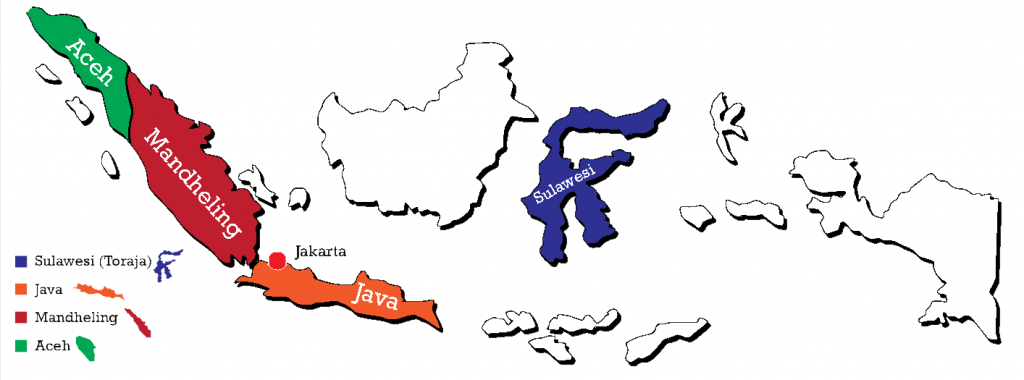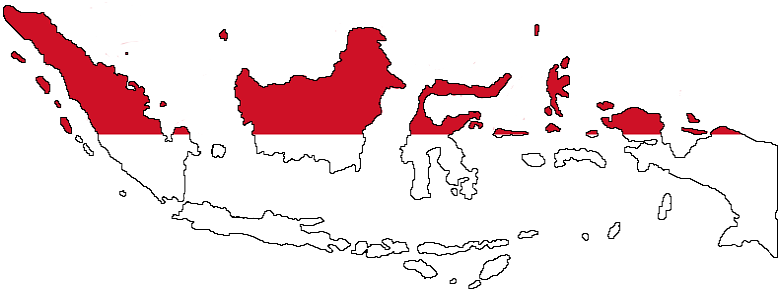Sumatra Mandheling Gr 1 ‘Kuda Mas’
About Indonesia (Sumatra) and its Coffee Production
Indonesia was the fourth-largest producer of coffee in the world in 2014. Coffee cultivation in Indonesia began in the late 1600s and early 1700s, in the early Dutch colonial period, and has played an important part in the growth of the country. Indonesia is geographically and climatologically well-suited for coffee plantations, near the equator and with numerous interior mountainous regions on its main islands, creating well-suited microclimates for the growth and production of coffee.
Indonesia produced an estimated 660,000 metric tons of coffee in 2017. Of this total, it is estimated that 154,800 tons were slated for domestic consumption in the 2013/2014 financial year. Of the exports, 25% are arabica beans; the balance is robusta. In general, Indonesia’s arabica coffee varieties have low acidity and strong bodies, which make them ideal for blending with higher-acidity coffees from Central America and East Africa.
There are more than 20 varieties of Coffea arabica being grown commercially in Indonesia. They fall into six main categories:
- Typica – this is the original cultivar introduced by the Dutch. Much of the Typica was lost in the late 1880s when coffee leaf rust swept through Indonesia. However, both the Bergandal and Sidikalang varieties of Typica can still be found in Sumatra, especially at higher altitudes.
- Hibrido de Timor (HDT) – This variety, which is also called “Tim Tim”, is a natural cross between Arabica and Robusta. This variety originated likely from a single coffee tree planted in 1917–18 or 1926. The HDT was planted in Aceh in 1979.
- Linie S – This is a group of varieties that were originally developed in India, from the Bourbon cultivar. The most common are S-288 and S-795, which are found in Lintong, Aceh, Flores and other areas.
- Ethiopian lines – These include Rambung and Abyssinia, which were brought to Java in 1928. Since then, they have been brought to Aceh as well. Another group of Ethiopian varieties found in Sumatra are called “USDA”, after an American project that brought them to Indonesia in the 1950s.
- Caturra cultivars: Caturra is a mutation of Bourbon coffee, which originated in Brazil.
- Catimor lines – This cross between Arabic and robusta has a reputation for poor flavour. However, there are numerous types of Catimor, including one that farmers have named “Ateng-Jaluk”. On-going research in Aceh has revealed locally adapted Catimor varieties with excellent cup characteristics.
Where does the Sumatra Mandheling Gr 1 ‘Kuda Mas’ come from?
Coffees from Sumatra are known for the smooth, sweet body that is balanced and intense. Depending on the region, or a blend of regions, the flavours of the land and processing can be very pronounced. Notes of cocoa, tobacco, smoke, earth and cedarwood can show well in the cup. Occasionally, Sumatran coffees can show greater acidity, which balances the body. This acidity takes on tropical fruit notes and sometimes an impression of grapefruit or lime. It grows at elevations up to 5,000 feet and as low as 2,500 feet above sea level.
Mandheling is a trading name, used for Arabic coffee from northern Sumatra. It was derived from the name of the Mandailing people, who produce coffee in the Tapanuli region of Sumatra. Mandheling coffee comes from Northern Sumatra, as well as Aceh.
“Kuda Mas” means golden horse in Bahasa (Bahasa is the official language of Indonesia).


What is Wet Hulled?
Wet hulling is the most common processing method used in Sumatra. Coffees processed this way are sometimes called natural or dry-processed, wet hulling is distinct from natural processing methods used in other parts of the world, such as Ethiopia. Wet hulling involves the following steps:
- Farmers remove the skin of the coffee cherry immediately after picking using homemade machines.
- The skinned coffee beans are placed in woven bags and left to ferment overnight
- The following morning, coffee farmers wash off the mucilage (remaining fruit) by hand
- The coffee beans, in their parchment, are partially dried in the coffee farmer’s yard
- The coffee beans are shipped to a warehouse, where the parchment is removed, and the coffee beans continue to dry
- The coffee beans are shipped to a port city for exportation and dried a third time at the port city
Sumatran coffee’s unique characteristics stem from wet hulling. The modified natural processing method and extended drying time produce coffees with muted flavours and aromas. Instead of being known for their notes, Sumatran coffees are typically characterized by their full bodies and low acidity. The aromas and flavours they do feature tend to be funky: earthy, spicy, wild, mossy, mushroomy.
Tasting Notes for Sumatra Mandheling Gr 1 ‘Kuda Mas’
| Country | Indonesia |
| Screen Size / Grade | SCR 17/18, GR 1 Triple Picked |
| Bean Appearance (green) | Fine finish, clean and well processed, the visual presentation is high |
| Acidity | Medium |
| Body | Bold intensity |
| Bag Size | 60kg |
| Harvest Period | March to June |
| Description | This is the best of the best Sumatrans; definitely one of the worlds tops beans. The ‘Kuda Mas’ Mandheling should rate in everyone’s top 10 choices perfect qualities abound, with great cup presence. This is a bean born to be presented as a single-origin offer, with so much complexity to be enjoyed in its own right. It makes a perfect addition to a top-grade blend. |
| Tasting Notes | The syrupy richness and a full buttery mouth feel. Lingering flavours of cedar, pepper spice, roast caramel and spiced fruits. |
| Strength | |
| Processing Method | Wet Hulled |
| Altitude | 1250 – 1450 MASL |
History of Coffee in Sumatra
The Dutch governor in Malabar (India) sent Arabic coffee (Coffea arabica) seedlings from Yemen to the Dutch governor of Batavia (now Jakarta) in 1696. The first seedlings failed due to flooding in Batavia. The second shipment of seedlings was sent in 1699 with Hendrik Zwaardecroon. The plants grew, and in 1711 the first exports were sent from Java to Europe by the Dutch East India Company, reaching 2000 pounds shipped in 1717. Indonesia was the first place, outside of Arabia and Ethiopia, where coffee was widely cultivated.
The coffee was shipped to Europe from the port of Batavia (now Jakarta). There has been a port at the mouth of Ciliwung River since 397 AD when King Purnawarman established the city he called Sunda Kelapa. Today, in the Kota area of Jakarta, one can find echoes of the seagoing legacy that built the city. Sail driven ships still load cargo in the old port. The Bahari museum occupies a former warehouse of the VOC, which was used to store spices and coffee. Menara Syahbandar (or Lookout Tower) was built in 1839 to replace the flag pole that stood at the head of wharves, where the VOC ships docked to load their cargos.
In the 18th century, coffee shipped from Batavia sold for 3 Guilders per kilogram in Amsterdam. Since annual incomes in Holland in the 18th century were between 200 and 400 Guilders, this was equivalent to several hundred dollars per kilogram today. By the end of the 18th century, the price had dropped to 0.6 Guilders per kilogram and coffee drinking spread from the elite to the general population. The East Indies were the most important coffee supplier in the world during this period and it was only in the 1840s that their stranglehold on supply was eclipsed by Brazil.
The coffee trade was very profitable for the VOC, and for the Dutch East Indies government that replaced it in 1800, but was less so for the Indonesian farmers who were forced to grow it by the colonial government from 1830 to around 1870 under the Cultuurstelsel (Cultivation system). Production of export crops was delivered to government warehouses instead of taxes. Coffee, along with sugar and indigo, was one of the main crops produced under this highly exploitative colonial system. Cultuurstelsel was applied to coffee in the Preanger region of West Java, as well as in West Sumatra, South Sulawesi and the Minahasa region of North Sulawesi. This corrupt system, which diverted labour from rice production and caused great hardship for farmers, was immortalized through an influential novel by Eduard Douwes Dekker (pen name – Multatuli) in 1860 titled Max Havelaar: Or the Coffee Auctions of the Dutch Trading Company. This book helped to change Dutch public opinion about the “Cultivation System” and colonialism in general. More recently, the name Max Havelaar was adopted by one of the first fair trade organizations.
By the mid-1870s the Dutch East Indies expanded arabica coffee-growing areas in Sumatra, Bali, Sulawesi and Timor. In Sulawesi, the coffee was thought to have been planted around 1850.[9] In North Sumatra highlands coffee was first grown near Lake Toba in 1888, followed in Gayo highland (Aceh) near Lake Laut Tawar in 1924. Coffee at the time was also grown in East Indonesia- East Timor and Flores. Both of these islands were originally under Portuguese control and the coffee was also C. arabica but from different rootstocks. The coffee in Eastern Indonesia was not affected to the same degree by rust, and even today, it is believed that some coffee in East Timor can be traced back to the 18th century.
In the late eighteen hundreds, Dutch colonialists established large coffee plantations on the Ijen Plateau in eastern Java. However, disaster struck in 1876, when the coffee rust disease, Hemileia Vastatrix, swept through Indonesia, wiping out most of the Arabica Typica cultivar. Robusta coffee (C. canephor var. robusta) was introduced to East Java in 1900 as a substitute, especially at lower altitudes, where the rust was particularly devastating. Robusta coffee was introduced to smallholders around Kerinci around 1915 and then spread quickly across southern Sumatra during the 1920s, where production soon eclipsed Java. The region remains the most important producing region by volume today.
Dutch-owned plantations on Java were nationalized in the 1950s, soon after independence. and are now managed as state-owned plantations under PTPN – Perusahaan Terbatas Perkebunan Nusantara, and revitalized with new varieties of Coffea arabica in the 1950s. These varieties were also adopted by smallholders through the government and various development programs.
Today, more than 90% of Indonesia’s coffee is grown by smallholders on farms averaging around one hectare. Some of this production is organic and many farmers’ cooperatives and exporters are internationally certified to market organic coffee.
Interested in some Sumatra?
Visit our Sumatra page or Espresso Bar to buy a bag of our Sumatra Mandheling Gr 1 ‘Kuda Mas’.
